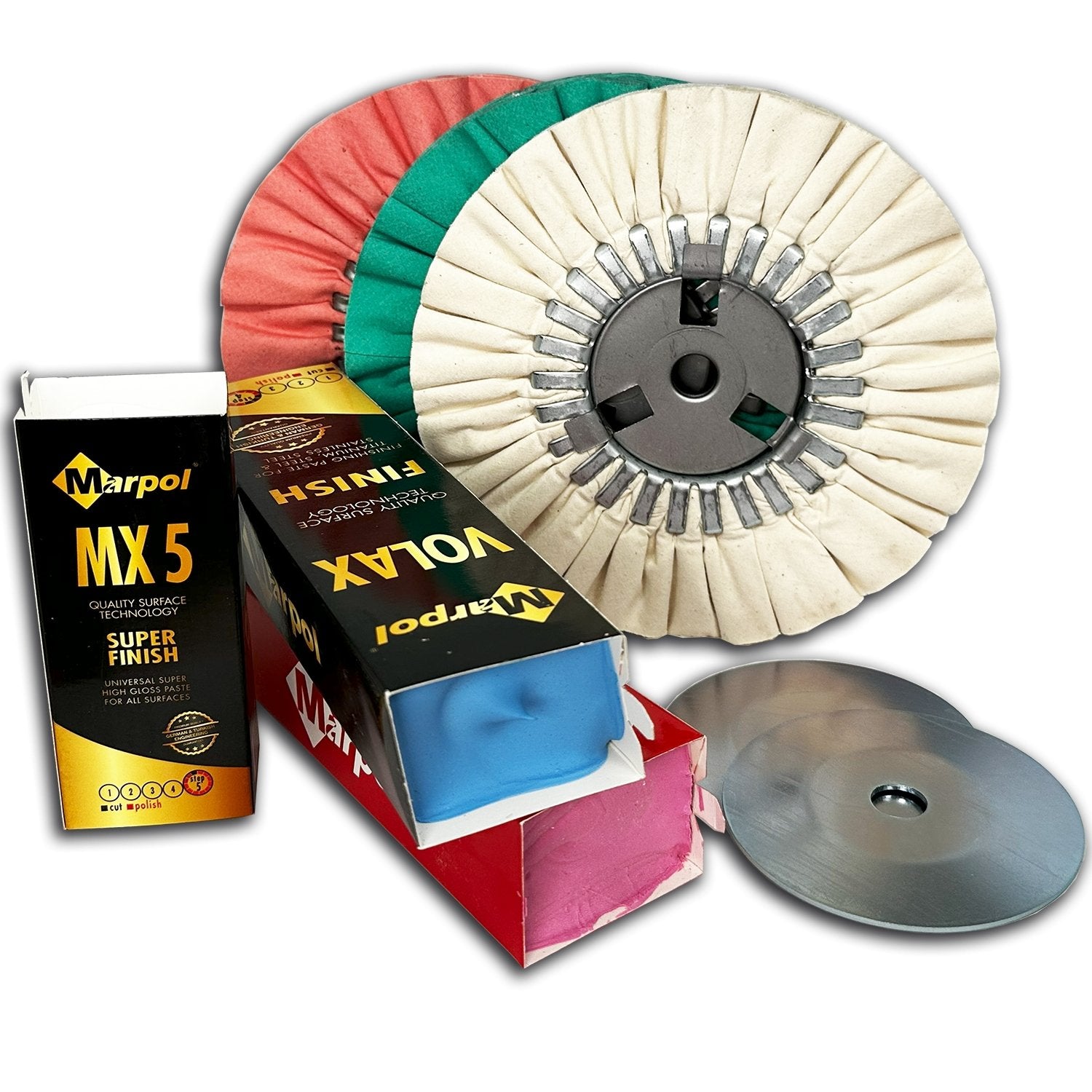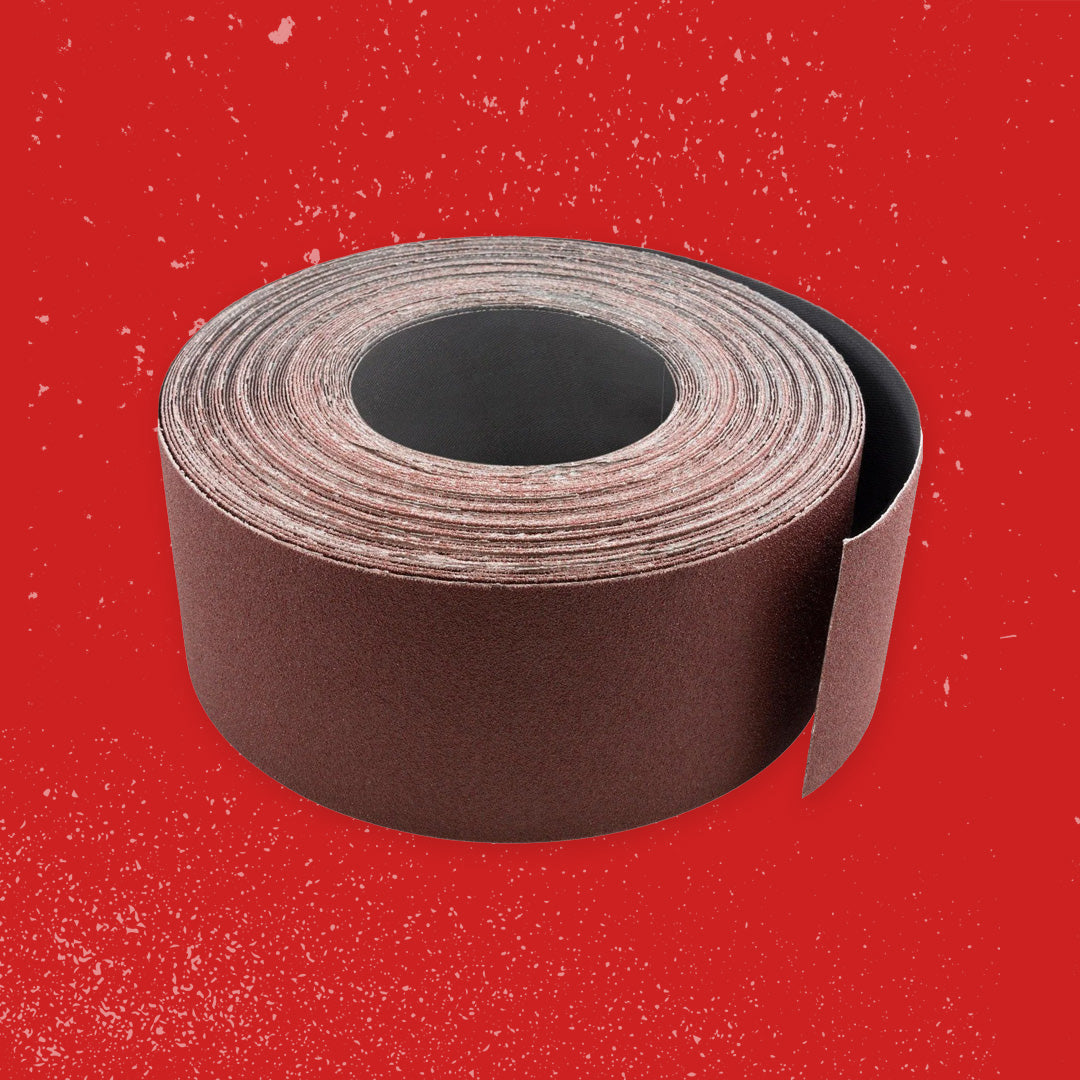Your Cart is Empty
Free Shipping over $150 (Excludes Oversized Products)
Free Shipping over $150 (Excludes Oversized Products)
Sanding Belts
Sanding Discs

How To Sand Glass: 3 Effective Methods
by David Kranker 6 min read

We use glass for a variety of purposes: as containers, window panes, and even decorations.In this blog, the team atRed Label Abrasives explains how to sand glass to make unique and even utilitarian items.
Can You Sand Glass Without Scratching It?
If you use the right material, you can sand glass without scratching it. In this case, ‘right material’ means using the right abrasive grain and grit. As an example, if you are sanding a rough glass surface to smooth it, you will need to start with wet 60-80 grit and then move to finer grits.
Sandpaper for Glass: Which Grain Is Best?
We recommend using silicon carbide for sanding and polishing glass. At Red Label Abrasives, we manufacture premiumsilicon carbide sanding belts,silicon carbide sanding discs, andsilicon carbide sanding sheets that achieve smooth results on glass, stone, stainless steel, and similar materials. Its anti-static properties reduce dust production while heat-resistant, anti-clogging stearate reduces loading.
Regardless of what grit you choose, keep the sandpaper wet at all times if your goal is a smooth surface. A paper-backed abrasive won’t work because it will fall apart when wet: our silicon carbide belts and discs are backed within X-weight cloth backing for both flexibility and durability.
Method #1: Using Sanding Belts, Discs, Or Sheets
For these steps, you’ll need the following to sand glass:
-
Water
-
Safety gloves and goggles
-
Abrasive (80 150, 220, 320, 400, 1000,and 2000-grit sandpaper)
-
Clean cloth
Step 1: Apply the Glass to Wet Sandpaper
Wet 80-grit sandpaper by dipping it into clean water, or spraying water onto the belt or disc with a bottle. If you’re using sanding sheets, lay your sheet out flat on a hard and durable work surface. Place the cut edge of the glass onto the surface of the abrasive. For maximum safety, put on safety goggles and gloves.
Step 2: Rotate the Glass on the Abrasive
Smooth the edge of the glass by moving it in a circular motion for five minutes. Drive the glass slightly into the sandpaper by applying gentle pressure. For a more uniform sanding, rotate the piece of glass every two or three circles. Otherwise, you may end up sanding one side of your glass much more than the rest, resulting in an uneven finish.
Aim to do this for at least around five minutes to ensure that the glass edge is adequately smoothed.
Step 3: Sand the Glass by Hand
Dip your sanding sheet in the water again to dampen it. Then place the sanding sheet over the glass edge so that your thumb and middle finger are over the corners and sand the sharp corners by rubbing the sheet back and forth. To keep it adequately moist, you may need to dip it into the water continuously.
Step 4: Use Progressively Finer Grits
Continue this process with increasingly finer grits of sandpaper. Make your glass even smoother by sanding down the edges with 150-grit, 220-grit, 320-grit, and finally 400-grit sandpaper. To polish the edge to perfection, use 1000- and 2000-grit sandpaper. After you've finished sanding, wipe the edge of the glass with a clean, damp cloth to remove any leftover dust or grit.
Method #2: Drill Sanding
You’ll need the following tools:
-
Rotatory power tool
-
Safety gloves and goggles
-
Ventilation mask
-
Sanding bit
-
Abrasive (60- to 100-grit)
-
Clean cloth
Step 1: Apply Sanding Bit to Appliance
Attach a sanding bit to a rotatory power tool. Sandpaper with a medium-grit finish (60- to 100-grit) and a relatively large sanding bit will yield the best results. Larger bits can smooth more of the edge at once.
Step 2: Sand the Glass Edges
For safety reasons, you should wear heavy-duty work gloves, eye protection, and a ventilation mask when sanding glass. In cases where your glass object is too small to be held safely by hand, you should clamp it, taking care to avoid accidental cracking
When the tool is powered on, hold the bit's side edge against the inside corner of the glass edge. Be careful not to apply too much pressure to the sanding bit, as this can lead to the glass breaking. Instead, simply hold the edge against it to allow it to smooth.
Smooth the inner edge of the glass by doing this for about three to five minutes. Then sand the glass edge at the top and outer corners. For a rounded edge, work from the center outwards. Continue rotating the bit until you have traveled around the entire outside edge- this shouldn’t take more than three to five minutes.
Step 3: Polish the Edge
Replace your sanding bit's sandpaper with a finer grit. Sand the glass edge again to make it even smoother. If necessary, polish the glass edge with increasingly finer grits of sandpaper until you achieve the desired smoothness. (Note: If you don't want to continue using the power tool, you can simply polish the glass edge by hand.) When you’re done, wipe away any leftover dust or grit with a clean damp cloth after sanding.
Method #3: Silicon Carbide Powder
Assemble the following:
-
Float glass
-
Foam rubber
-
Water
-
Coarse grit silicon carbide powder
-
Safety gloves
Step 1: Lay Float Glass on Foam Rubber
Lay a piece of float glass over a piece of foam rubber. The float glass will serve as your work surface for grinding glass edges. The foam rubber keeps the float glass in place during grinding so it won't slide off. A piece of scrap plate glass, such as a window, mirror, or picture glass, can also be used if you don't have float glass.
Step 2: Apply Silicon Carbide
Make a small puddle in the center of your float glass by pouring water into it. Add just enough silicon carbide to cover the puddle's surface. To finish, gently stir the water and powder together with your fingers.
Place the sharp edge of the glass over the area where the silicon carbide and water were mixed. (Wear safety gloves to prevent cutting your hands on glass.)
Spend 30-60 seconds circling the bottle around the glass in a figure eight motion. Apply gentle downward pressure to the glass as you move it over and through the silicon carbide, staying within the puddle. When you have been circling for about a minute, look at the glass' edge. Once the glass has become smooth all over and no longer glossy, you are done.
Step 3: Apply Sandpaper
To smooth the inside of the glass, wipe it off with a towel and use a sanding sheet. Using a damp paper towel or a cloth towel, wipe the silicon carbide water off the glass piece. Wet sandpaper can then be used to smooth out the inner corners of the glass edge, if necessary. Sandpaper can also be used to smooth out any rough spots left over from the silicon carbide.
Can Glass Be Dry-Sanded?
It depends on what you’re trying to achieve. For a polishing effect, you’ll want to use wet abrasives because they lubricate the surface and prevent gouging or scratching, but if your goal is to increase or decrease the opacity of a glass surface (such as frosting- more on that below), you’ll want to dry-sand it.
How To Sand Glass for a Frosted Effect
Frosting provides a semi-opaque appearance that will add style to any piece of glasswork. You’ll need the following:
-
Rotary tool with sandpaper bits
-
Sharpie or similar marker
-
Cotton swab
-
Nail polish remover
-
Painter’s or masking tape
Using a permanent marker, draw out the frosted shape you want. If you make a mistake, use some cotton swabs soaked in nail polish remover to erase it. Once you’re satisfied with the design, use masking tape or painter's tape to cover areas you don't want to be frosted. When covering tight corners and curved edges, use small tape pieces cut to the right shape.
Attach a sanding bit to the rotatory power tool and set its speed level at medium. Using short strokes, sand the area you outlined with the marker. Remove all the clear areas inside the outline and do not use the tool on the masked areas.
After you’ve covered the targeted surface, use a small circle of sandpaper to work the inner outline of the frosted area. Sandpaper should also be used on the frosted area. This will help make the appearance more uniform. When sanding narrow areas or fine lines, fold the paper in half and use the folded edge. When done, unwrap the tape and wipe away any remaining tracing lines.
About Red Label Abrasives
Red Label Abrasives produces abrasives specifically designed for glass, plastic, stone, and other surfaces. At Red Label, we manufacture a wide range of premium abrasives for every possible application, from smoothing glass to producing furniture.
With over 35 years of manufacturing experience, Red Label offers superior abrasives backed by equally outstanding customer support. We can help you select the rightsanding belts,sanding discs, orsanding sheets and pads for your operation. We can also custom-manufacture products for unique applications. For more information about our products and services, please contact us byfilling out a contact form or calling 844-824-1956.
ABOUT THE AUTHOR
David Kranker is a writer and creative maker who has been covering the abrasive industry on the Red Label Abrasives Blog since 2020. David spends his time continually researching sanding techniques to provide readers with the latest and greatest information. In his free time, David utilizes abrasives for many different home and auto projects at his home in Delton, MI.
Our Most Popular Abrasives

EdgeCore Ceramic Sanding Belts

EdgeCore Ceramic Flap Discs

Buffing Kit
Shop By Product Category





Why Choose Red Label?







